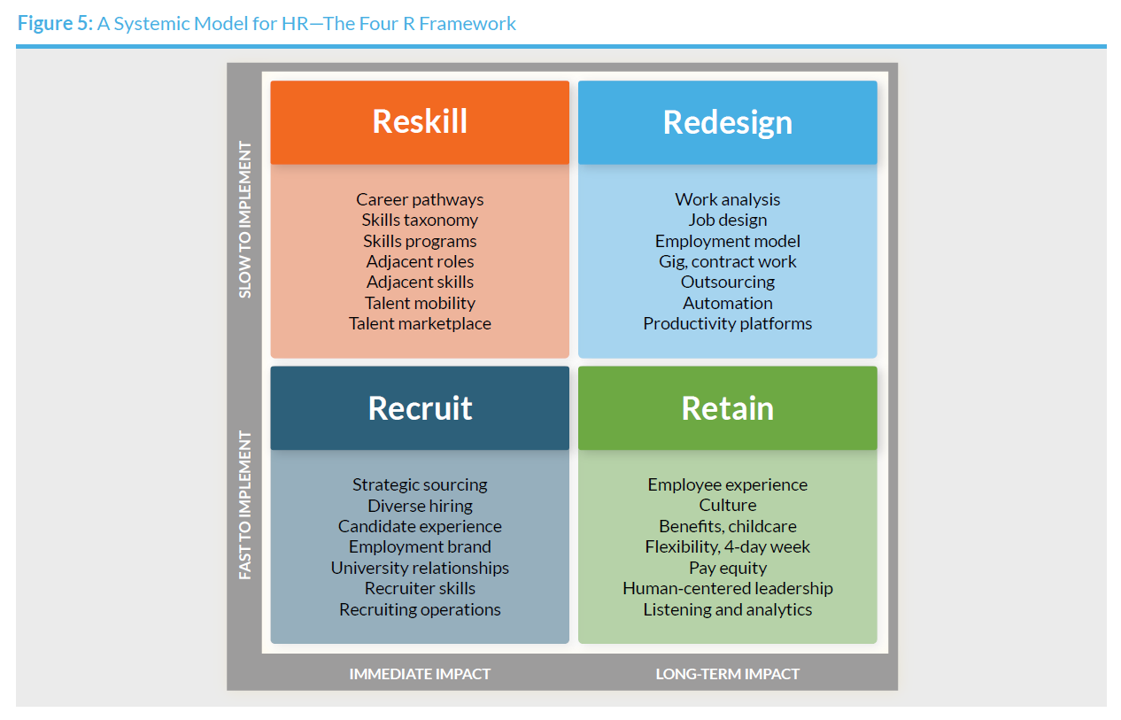Josh Bersin: Talent scarcity isn’t going away. It’s time to re-think jobs altogether
- 5 Min Read
The latest research from The Josh Bersin Company tells us talent scarcity is here to stay. The solution is to re-think our approach to jobs by shifting to systemic HR. Josh Bersin joins HRD Connect to discuss this shift and how the ‘Four R’ framework can help.
- Author: Josh Bersin
- Date published: Nov 9, 2023
- Categories

It’s been another tough year for HR. Even the most optimistic HR leader would admit that issues such as talent scarcity are not going away and organizational change feels relentless. Describing each new challenge as ‘The New Normal’ has become, well… the new normal. Can organizations expect any respite, or must HR leaders adopt a new approach to cope with constant change?
The research tells us the latter. Talent scarcity, argues Josh Bersin in another exclusive interview for HRD Connect, is here to stay. What’s more, this renders our current definition of jobs obsolete. HR, he argues, must rethink its definition of jobs. In this Q&A he outlines the ‘Four R’ model and how it can help organizations shift to redefine jobs, shift to systemic HR, and achieve organizational productivity.
1. Why do you believe talent scarcity will not ease with more favorable economic conditions, but is instead a new norm of the industrial age?
Talent scarcity will not ease because the demographics of our workforce are changing. A combination of low birth rates, delayed marriage, and an aging population is reducing the size of the labor force.
Japan, Germany, and the UK, for example, are already experiencing dramatic workforce shortages. It’s particularly acute in Italy. The World Bank predicts basic demographics mean all developed economies will face this truth in the next 10-15 years.
2. How do our current definitions of ‘jobs’ get in the way of organizational productivity?
The old idea of a ‘job’ as a ‘container’ for an individual creates many problems. When a company has a new product, initiative, or reorganization, people try to hold onto their jobs and are afraid to try something new unless it’s a promotion or viewed as a positive new job. This essentially stops companies from innovating and adapting, forcing companies to simplify job architectures and make ‘jobs’ more general.
As HR leaders, we should widely encourage a move to make jobs more general. It enables every worker to work on multiple projects, learn and contribute in new ways, and develop themselves much more quickly. Job levels and titles won’t go away entirely. Slowly but surely they will become more of a generic title with ‘roles’ assigned.
For example, an engineer may function as a specialist, project leader, coach, and manager all at once. Every organization we talk to is simplifying its job architecture to get a better handle on the skills of individuals, not just the skills we conceptually tie to a definition of a job.
3. Can you outline the ‘Four R’ framework and how it can help HR Leaders make a fundamental shift to Systemic HR?
The ‘Four Rs’ (Recruit, Retain, Reskill, Redesign) is a model to help companies think through their overall growth strategy without being locked into ‘hire hire hire’ to grow.

In today’s constrained labor environment, we need this model because we cannot fill roles such as nurses, medical technicians, or specialist software engineers with recruiting. It can be up to six times less expensive to develop these people internally versus trying to hire externally. And in addition to reskilling and internal mobility, as HR people, we want to be much more thoughtful about our organizations. ‘Why is this job open? Why are people leaving? Do we need to improve retention?’ And finally, ‘should we redesign this job so we don’t need so many people?’
All four of these Rs are typically distributed into different HR groups, and if we consider them all together with a systemic approach, companies can grow in a much more productive and sustainable way and stop the hire and fire cycle which won’t be possible in the future anyway.
4. What ‘fast to implement’ Recruit and Retain transformations are non-negotiable for addressing talent scarcity within the next 6 months?
The single most important Recruit or Retain focus now is to ‘define a role that matters.’ In other words, we must define each job in a way that is ‘fillable’ and growth-oriented for the individual. If we do that and make jobs flexible, include development and growth in the role, and create a culture of growth and support, people will flock to that job and stay in the company.
Part of this is job design but part is management, rewards, flexibility, and benefits. We call this ‘Irresistible Leadership.’
5. Reskill and Redesign are slow to implement. How can HR leaders avoid falling back into outdated operating models?
The number one thing is to stop hiring and look at ‘How do we grow this group?’ or ‘How do we improve output without necessarily hiring anyone at all?’ This constrained focus forces the HR and leadership team to look at technologies, tools, skills, organization design, and eliminating bureaucracy to grow the company.
The good news is that when we look at ground-level design for performance improvement, you can almost always find a way to grow without just hiring more and more people, which often just reduces productivity.









